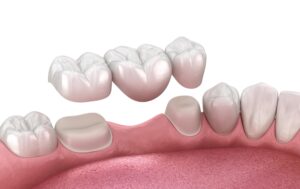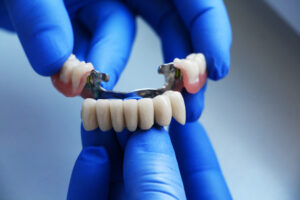 If you’re dealing with missing teeth, choosing the right solution is key to restoring your oral health and confidence. A dental bridge offers a time-tested, effective way to replace one or more missing teeth with natural-looking results. When you work with an experienced provider like Dr. Egger i Mount Pleasant, you’re choosing a personalized approach backed by expertise, comfort, and a commitment to long-term oral health.
If you’re dealing with missing teeth, choosing the right solution is key to restoring your oral health and confidence. A dental bridge offers a time-tested, effective way to replace one or more missing teeth with natural-looking results. When you work with an experienced provider like Dr. Egger i Mount Pleasant, you’re choosing a personalized approach backed by expertise, comfort, and a commitment to long-term oral health.
What Is A Dental Bridge?
A dental bridge is a custom-made restoration that “bridges” the gap left by one or more missing teeth. It typically involves one or more artificial teeth (pontics) held in place by crowns attached to the neighboring natural teeth or implants. Whether you’ve lost a tooth due to injury, decay, or gum disease, a bridge helps restore both function and appearance.
Benefits Of Choosing A Dental Bridge
Restore Your Smile And Confidence
Missing teeth can affect more than your appearance—they can impact your speech, chewing ability, and self-esteem. A dental bridge helps you regain a full, natural-looking smile that boosts your confidence in everyday interactions.
Improve Chewing And Speech
Teeth play an essential role in how you eat and speak. Without a full set of teeth, chewing can become difficult, and speech may be affected. A dental bridge allows you to enjoy your favorite foods again and speak clearly without discomfort or hesitation.
Prevent Teeth From Shifting
When a tooth is lost, the surrounding teeth can begin to shift out of place, leading to bite issues and jaw pain. A dental bridge helps maintain the proper alignment of your teeth and prevents future complications.
Long-Lasting And Cost-Effective
With proper care, a dental bridge can last well over a decade, making it a reliable and cost-effective option for tooth replacement. Regular checkups and good oral hygiene help extend the lifespan of your bridge.
Aesthetic And Functional Results
Dental bridges are designed to blend seamlessly with your existing teeth. They not only restore function but also look natural, helping you maintain a bright and uniform smile.
Schedule A Consultation With Dr. Egger Today
Don’t let missing teeth disrupt your quality of life. Schedule a consultation with Dr. Egger at Mount Pleasant Family Dental Center in Mount Pleasant, Michigan. With a focus on compassionate care and lasting results, you’re in skilled hands. Call 989-773-3560 to get started on restoring your smile.


 Replacing missing teeth with
Replacing missing teeth with 
 Missing teeth can significantly impact your oral health, self-esteem, and overall quality of life. Whether you have lost a tooth due to injury or periodontal disease, you should address the gap promptly to prevent further dental issues.
Missing teeth can significantly impact your oral health, self-esteem, and overall quality of life. Whether you have lost a tooth due to injury or periodontal disease, you should address the gap promptly to prevent further dental issues. 



